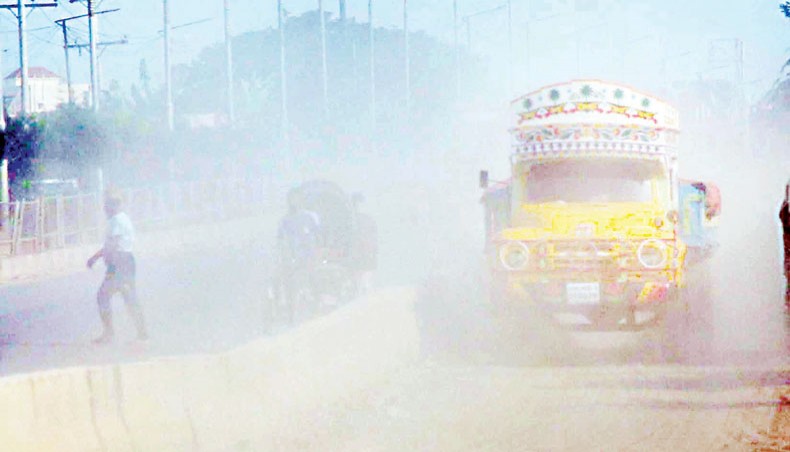
Air pollution causes huge pregnancy loss

Air pollution has been associated with a significant proportion of pregnancy loss in Bangladesh, India and Pakistan, according to a study published in the Lancet.
The study said that in Bangladesh India and Pakistan, air pollution might have contributed to 29 per cent of pregnancy losses.
Bangladesh was named the world’s most polluted country for PM2.5 exposure in the 2019 World Air Quality Report.
Fine particulate matter or PM2.5 of less than 12 micrograms per cubic metre is considered good although the World Health Organisation targets the countries that achieve PM2.5 less than 10 µg/m³.
Bangladesh’s average PM2.5 was 83.30 µg/m³ in 2019, according to the 2019 World Air Quality Report published in 2020.
The Lancet study, published this January, included 34,197 women in the region, who had suffered loss of pregnancy, including 27,480 miscarriage and 6,717 stillbirths. Of these pregnancy losses, 77 per cent were in India, 12 per cent in Pakistan and 11 per cent in Bangladesh.
The study also said that during 2010-2015, about 178 million, 25.5 per cent of 698 million babies born globally, were born in India, Pakistan and Bangladesh, but 9,17,800, or 35.0 per cent of 26,20,000 stillbirths occurred in these countries.
The epidemiological case-control study, the first to quantify the impact of air pollution on pregnancy loss in South Asia, said that exposure among mothers to fine particulate matter or PM 2.5 was associated with pregnancy loss, which includes stillbirths and miscarriages.
The study stated that South Asia was one of the polluted regions in the world and had the highest burden of pregnancy loss globally.
Lead author of the study, Tao Xue of Peking University in China, said that South Asia has the highest burden of pregnancy loss globally and is one of the most PM 2.5 polluted regions in the world.
‘Our findings suggest that poor air quality could be responsible for a considerable burden of pregnancy loss in the region, providing further justification for urgent action to tackle dangerous levels of pollution,’ he said.
The data for the study was collected from the Demographic Health Surveys from India, Pakistan, and Bangladesh during 1998-2016, for women who reported at least one pregnancy loss and one or more live births.
The researchers estimated that exposure to PM2.5 air quality during pregnancy by studying various modelling outputs.
They created a model to examine how exposure to air quality of PM2.5 increased women’s risk of pregnancy loss. They did this by calculating the risk for each increase in 10 micrograms per cubic metre (10 mg/m3) in PM2.5 after taking into account maternal age, humidity, seasonal variation, and temperature.
The team then calculated the number of pregnancy losses, which might have been caused in the region from 2000-2016 due to exposure to PM2.5. It found that a 7 per cent annual pregnancy loss was due to exposure to PM2.5 when India’s air quality exceeded the acceptable limits for that time period.
The study also found that a woman’s risk of pregnancy loss increased by 3 per cent with each increase in 10 mg/m3, and that air pollution could have contributed to 29 per cent of the pregnancy losses.
The study, however, pointed out some limitations in their research.
It said gaps such as the under-reporting of pregnancy losses, either due to stigma or ignoring pregnancy losses that occurred during the early gestational stage, could result in an underestimation of the link between poor air quality and pregnancy loss.
The High Court in January 2020, issued nine directives to the government to curb the capital’s air pollution.
In the directives, the court asked the government to shut down brick kilns in and around the capital, ban black smoke-emitting and life expired vehicles and compel owners of markets, shops and houses to develop own waste collection system.
The government was also asked to ensure covering construction materials by contractors, immediate repair of roads dug after completion of work by the utility services, no entry of uncovered truck to the capital and spraying water on the roads twice every day.
The court also directed the Department of Environment to shut down factories that burn tyres and recycle batteries to earn money and in the process cause harm to public health and environment.
The High Court again in November 2020, asked the authorities concerned to submit reports to on steps taken in compliance with the nine directives as those were hardly followed.
Editor & Publisher: S. M. Mesbah Uddin
Published by the Editor from House-45,
Road-3, Section-12, Pallabi, Mirpur
Dhaka-1216, Bangladesh
Call: +01713180024 & 0167 538 3357
News & Commercial Office :
Phone: 096 9612 7234 & 096 1175 5298
e-mail: financialpostbd@gmail.com
HAC & Marketing (Advertisement)
Call: 01616 521 297
e-mail: tdfpad@gmail.com